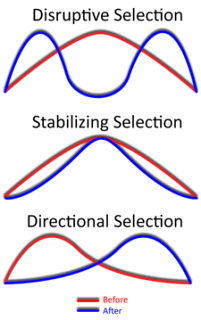Directional selection is a function of natural selection in which a single phenotype is favored, causing the allele frequency to continuously shift in one direction. In directional selection, the different allele increases in frequency independently of its dominance relative to other alleles. Directional selection stands in opposite to balancing selection where selection may favor multiple alleles, and is the same as purifying selection which removes harmful mutations from a population. An example can be found in the breeding of the greyhound dog. Early breeders were interested in dog with the greatest speed. They carefully selected from a group of hounds those who ran the fastest. From their offspring, the greyhound breeders again selected those dogs who ran the fastest. By continuing this selection for those dogs who ran faster than most of the hound dog population, they gradually produced a dog who could run up to 64km/h (40mph).
Stabilizing selection is also a type of natural selection where genetic diversity decreases as the population stabilizes on a particular trait value. This is probably the most common mechanism of action for natural selection. Stabilizing selection commonly uses negative selection to select against extreme values of the character. Stabilizing selection acts to prevent divergence of form and function. An example of stabilizing selection is human birth weight. Babies of low weight lose heat more quickly and get ill from infectious diseases easily, but babies with large body weight are difficult to deliver through the pelvis.
Disruptive selection favors the extremes of a range of selection. Disruptive selection refers to natural selection that favors phenotypic extremes. An example of this is a population of seed-eating birds with beaks that range in size, so that big beaks are best adapted to eating big seeds, small beaks are best adapted to small seeds, and medium beaks are best adapted to medium seeds. Now suppose that the source of medium seeds goes extinct it looses its food source, selection favors the big and small beaks.

No comments:
Post a Comment